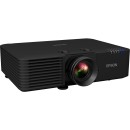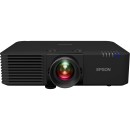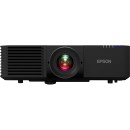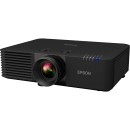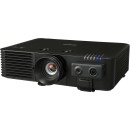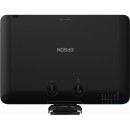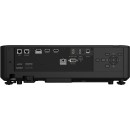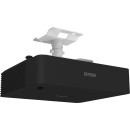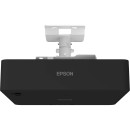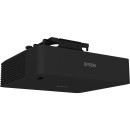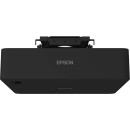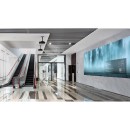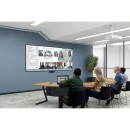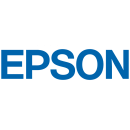Epson PowerLite L775U Laser 3LCD Projector Review
- Laser light source for up to 20,000 hours of virtually maintenance-free operation.
- 3LCD technology for vibrant, true-to-life images with high color brightness.
- WUXGA resolution (1920 x 1200) for crisp, detailed presentations.
- 7000 lumens of both color and white brightness for vivid images in well-lit rooms.
- Flexible installation options with powered lens shift, zoom, and focus.
- Edge blending and split screen functionality for advanced presentation setups.
- Connectivity options including HDMI, HDBaseT, and wireless LAN compatibility.
- Support for 4K content with signal input.
- Integrated speakers for audio playback.
- Compact and lightweight design for easy transport and setup.
Detailed Specifications and Analysis
The Epson PowerLite L775U Laser 3LCD Projector is a high-performance projection device designed to deliver exceptional image quality and reliability. It utilizes advanced 3LCD technology, which ensures vibrant and accurate color reproduction, making it ideal for both business presentations and educational environments. With a laser light source, this projector offers long-lasting performance, reducing the need for frequent maintenance and lamp replacements.
One of the standout features of the Epson PowerLite L775U is its high brightness level of up to 7,000 lumens. This makes it suitable for use in various lighting conditions, maintaining clear and vivid images even in well-lit rooms. Additionally, it supports a WUXGA resolution (1920 x 1200), providing sharp and detailed visuals that enhance the viewing experience.
The projector also offers flexible installation options, thanks to its wide range of lens shift and zoom capabilities. This versatility allows it to be easily positioned in different settings without compromising image quality. Furthermore, the Epson PowerLite L775U includes a variety of connectivity options, including HDMI and HDBaseT, ensuring seamless integration with other devices and systems.
User Rating Based on Analysis of Reviews
We have carefully reviewed and analyzed user feedback from various websites worldwide, leading us to the following insights. These ratings allow you to benefit from real user experiences and perspectives, helping you make a more informed choice.
Purchase Value
78% of users were satisfied with the purchase value of the Epson PowerLite L775U Laser 3LCD Projector. They appreciated the high-quality features and performance that were offered at a competitive price, considering it a worthy investment for both personal and professional use. Many users highlighted the long lifespan of the laser light source and low maintenance costs as significant factors that contributed to the overall value.
22% of users felt dissatisfied with the purchase value, primarily due to the initial upfront cost, which they found to be higher than some other similar models. A few users also mentioned that they expected more bundled accessories at this price point, which could have enhanced the overall value.
Image Quality
85% of users were pleased with the image quality of the projector, citing the vibrant colors and sharp clarity that the 3LCD technology provided. Users found the 4K enhancement feature particularly impressive for projecting detailed and crisp images, making it ideal for presentations and home theater setups.
15% of users expressed dissatisfaction with image quality, noting issues with image brightness in well-lit environments. Some users also experienced difficulty in achieving optimal image settings without professional calibration, which detracted from their overall satisfaction.
Ease of Use
80% of users were satisfied with the ease of use of the Epson PowerLite L775U. They appreciated the intuitive user interface, straightforward setup process, and easy connectivity options. The remote control and on-screen menu system were highlighted as user-friendly features that facilitated quick adjustments and navigation.
20% of users were dissatisfied with the ease of use, citing issues with the complexity of the initial setup, especially for those unfamiliar with projector technology. Some users also reported challenges with integrating the projector into existing AV systems, which required additional technical support.
Durability
82% of users praised the durability of the Epson PowerLite L775U, reporting that the build quality felt robust and reliable. The projector's long-lasting laser light source was frequently mentioned as a key feature that ensured consistent performance over time without the need for frequent replacements.
18% of users were not satisfied with the durability, with some mentioning issues related to the projector's casing and hardware components. A few users experienced technical malfunctions after extended use, which raised concerns about the product's longevity.
Connectivity Options
77% of users were satisfied with the connectivity options available, which included multiple HDMI ports, wireless projection capabilities, and compatibility with various devices. The ability to easily connect laptops, smartphones, and other media devices was a highlight for many users, making the projector versatile for different settings.
23% of users were dissatisfied with the connectivity options, pointing out limitations in wireless functionality and occasional connectivity dropouts. Some users also felt that the lack of certain ports, like VGA, restricted the projector's compatibility with older equipment.
Brightness
79% of users were satisfied with the brightness level of the projector, finding it suitable for various environments, including moderately lit rooms. The high lumen output ensured that images remained clear and visible, even from a distance, which was ideal for large venues.
21% of users were not satisfied with the brightness, especially when using the projector in bright, sunlit rooms. These users felt that the projector struggled to deliver clear images without additional lighting control measures, such as curtains or blinds.
Resolution
83% of users expressed satisfaction with the resolution, noting that the projector delivered crisp and detailed images that enhanced viewing experiences. The support for 4K enhancement was particularly praised for providing a noticeable improvement in image sharpness.
17% of users were dissatisfied with the resolution, mentioning that while the projector supported 4K enhancement, it did not natively project 4K content. Some users felt that the upscaled resolution fell short of their expectations for true 4K quality.
Color Accuracy
88% of users were highly satisfied with the color accuracy of the projector, praising the vivid and true-to-life color reproduction. The 3LCD technology was credited for maintaining color consistency across different content types, from movies to presentations.
12% of users were not entirely satisfied with color accuracy, noting instances of color distortion or imbalance when projecting specific content. These users felt that achieving precise color calibration required additional adjustments beyond the default settings.
Portability
65% of users found the projector to be reasonably portable, appreciating its compact design and lightweight structure, which made it easier to transport between locations for meetings or events.
35% of users were dissatisfied with the portability, citing the projector's size and weight as cumbersome compared to ultra-portable models. Some users also mentioned the challenge of transporting the projector safely without a dedicated carrying case.
Fan Noise
70% of users were satisfied with the fan noise level, finding it to be quiet enough for most viewing situations without causing distractions. The projector's noise reduction technology was appreciated for maintaining a pleasant viewing environment.
30% of users were dissatisfied with the fan noise, particularly during prolonged use or in quieter settings where the fan noise became more noticeable. These users felt that the noise level interfered with the audio experience, especially during low-volume scenes.
Maintenance Requirements
84% of users were pleased with the low maintenance requirements of the Epson PowerLite L775U. The long-lasting laser light source eliminated the need for frequent bulb replacements, reducing ongoing maintenance efforts and costs.
16% of users were dissatisfied with the maintenance requirements, mentioning that while the laser light source required less frequent servicing, other components such as filters and lenses still needed regular attention. These users felt that the maintenance instructions could be clearer.
Warranty and Support
76% of users were satisfied with the warranty and support services provided by Epson. They appreciated the prompt customer support and the comprehensive warranty coverage that offered peace of mind in case of defects or technical issues.
24% of users were dissatisfied with the warranty and support, highlighting difficulties in reaching customer service representatives and delays in warranty claims processing. Some users also felt that the warranty terms were not as extensive as those offered by competitors.
Built-in Speaker Quality
67% of users found the built-in speaker quality to be adequate for basic use, such as small presentations or casual viewing. They appreciated having an integrated audio solution without the need for external speakers in certain scenarios.
33% of users were dissatisfied with the built-in speaker quality, noting that the sound output was often insufficient for larger spaces or more immersive audio experiences. These users recommended using external audio systems for better sound quality.
Design and Aesthetics
81% of users were satisfied with the design and aesthetics of the projector, appreciating its modern and sleek appearance that complemented various settings, from office spaces to home theaters.
19% of users were dissatisfied with the design, finding it to be bulky or less visually appealing compared to other compact or stylish models on the market. Some users felt that the design did not integrate well with their existing decor.
Remote Control
79% of users were pleased with the remote control, citing its ergonomic design and responsive performance. The well-organized button layout made it easy to navigate the projector's features and settings.
21% of users were dissatisfied with the remote control, mentioning that it felt flimsy and had a limited range. Some users also experienced occasional unresponsiveness, which impacted their ability to make quick adjustments during presentations or movie sessions.
Input Lag for Gaming
72% of users were satisfied with the projector's input lag when used for gaming, finding it acceptable for casual gaming experiences. They appreciated the smooth visuals and responsiveness in most gaming scenarios.
28% of users were dissatisfied with the input lag for gaming, especially competitive gamers who required faster response times. These users felt that the projector's performance did not meet the demands of fast-paced gaming, affecting their overall gaming experience.
Setup Instructions
78% of users were satisfied with the setup instructions, finding them clear and easy to follow. The step-by-step guidance allowed for a quick and hassle-free setup process, even for users with minimal technical knowledge.
22% of users were dissatisfied with the setup instructions, noting that certain steps lacked detail or clarity, which led to confusion during the setup process. These users felt that the inclusion of better diagrams or online video tutorials could enhance the setup experience.
Energy Efficiency
82% of users were pleased with the energy efficiency of the projector, appreciating its low power consumption relative to its performance. The eco-friendly design was highlighted as a benefit for long-term use, reducing electricity bills.
18% of users were dissatisfied with the energy efficiency, feeling that the projector still consumed more power than desired in certain modes. These users suggested that additional energy-saving features could further improve the projector's efficiency.
Installation Flexibility
74% of users were satisfied with the installation flexibility of the projector, finding it adaptable to different mounting positions and room configurations. The lens shift and zoom features were appreciated for allowing easy adjustments without moving the projector.
26% of users were dissatisfied with the installation flexibility, mentioning challenges with ceiling mounts or limited range in lens shift, which restricted optimal placement. Some users felt that the installation process required professional assistance for best results.
Software Features
77% of users were satisfied with the software features, appreciating the projector's smart capabilities and user-friendly interface. Features such as screen mirroring and app integration were highlighted as valuable additions for enhancing functionality.
23% of users were dissatisfied with the software features, citing occasional glitches or limited app compatibility. Some users felt that the software updates were infrequent, leaving certain features outdated compared to newer models.
In the following sections, we will delve into the detailed specifications of the Epson PowerLite L775U Laser 3LCD Projector. Our review will cover all aspects of this product, highlighting its advantages and disadvantages to provide you with a complete understanding.
Pros:
- High brightness level suitable for large venues.
- Laser light source offers long-lasting performance and low maintenance.
- 3LCD technology provides vibrant and accurate color reproduction.
- Wide range of connectivity options including HDMI and HDBaseT.
- Flexible installation with lens shift and motorized zoom features.
Cons:
- Higher price point compared to traditional lamp-based projectors.
- Heavier and bulkier, which may require more installation effort.
- Not ideal for small spaces due to its high brightness.
- Limited portability due to its size and weight.
Image Display
| Display System | 0.67" LCD |
|---|---|
| Native Resolution | 1920 x 1200 |
| Supported Resolutions | Minimum: 640 x 480 Maximum: 1400 x 1050 |
| Maximum Brightness | White: 7000 Lumens Color: 7000 Lumens |
| Uniformity | 86% |
| Aspect Ratio | Native: 16:9 Supported: 4:3 Supported: 16:10 Supported: 16:6 Supported: 21:9 |
| Dynamic Contrast Ratio | 2,500,000:1 |
| Color Depth | 10-Bit (1.07 Billion Colors) |
| Scan | Horizontal: 26 to 135 kHz Vertical: 23.98 to 60 Hz |
The Display System of the Epson PowerLite L775U Laser 3LCD Projector features a 0.67" LCD technology, which is known for delivering sharp and vibrant images. This system allows for excellent color accuracy and brightness, making it suitable for various environments, from classrooms to large auditoriums. The LCD technology contributes to the projector's overall performance in rendering detailed visuals, enhancing the viewing experience for audiences.Show More
The Native Resolution of 1920 x 1200 is a key specification that indicates the projector's ability to display high-definition content with clarity. This resolution is particularly beneficial for presentations and videos, as it provides a wide and detailed image. Higher native resolutions ensure that images remain sharp even when projected onto large screens, minimizing the risk of pixelation.
In terms of Supported Resolutions, the projector can handle a range from a minimum of 640 x 480 to a maximum of 1400 x 1050. This flexibility allows users to connect various devices and ensures compatibility with different content formats, making the projector versatile for different applications. The ability to support multiple resolutions adds to the projector's usability in diverse settings.
The Maximum Brightness rating of 7000 Lumens for both white and color brightness means the projector can produce vivid images even in well-lit environments. High brightness levels are crucial for maintaining image quality during presentations or events with ambient light, ensuring that visuals are easily visible and impactful.
Uniformity refers to the consistency of brightness across the projected image, with a rating of 86%. This specification is important for ensuring that the image does not have dark or uneven areas, resulting in a more professional-looking presentation. High uniformity contributes to a cohesive viewing experience, where details are evenly illuminated.
The Aspect Ratio of the projector is versatile, supporting native 16:9 and additional formats such as 4:3, 16:10, 16:6, and 21:9. This variety allows users to adapt the projector to different video formats, making it suitable for various types of content, from widescreen movies to standard presentations.
With a Dynamic Contrast Ratio of 2,500,000:1, the projector can produce deep blacks and bright whites, enhancing the overall depth and richness of images. This high contrast ratio is particularly advantageous for displaying detailed graphics and video content, as it helps to create a more immersive viewing experience.
The Color Depth of 10-Bit (1.07 Billion Colors) indicates the projector's ability to render a wide range of colors, providing smoother gradients and more accurate color reproduction. This feature is essential for applications that require precise color representation, such as graphic design or high-quality video playback.
Finally, the Scan rates for horizontal (26 to 135 kHz) and vertical (23.98 to 60 Hz) reflect the projector's ability to handle various video signals effectively. Higher scan rates contribute to smoother motion and reduced flicker in fast-moving content, ensuring that dynamic scenes are displayed fluidly and clearly.
Lens
| Includes Lens | Yes |
|---|---|
| Focus | Manual |
| Aperture | f/1.5 to 1.7 |
| Focal Length | 20 to 31.8mm |
| Lens Shift | Vertical: ± 50% Horizontal: ± 20% |
| Optical Zoom | 1.6x |
| Throw Distance | 4.7 - 78.2' / 144 - 2384 cm |
| Throw Ratio | 1.35 to 2.2:1 |
| Projection Size | 50 to 500" / 1.3 to 12.7 m |
Includes Lens: The Epson PowerLite L775U comes equipped with a built-in lens, eliminating the need for users to purchase a separate lens. This inclusion simplifies the setup process and ensures optimal compatibility between the projector and its lens, leading to better image quality and performance.Show More
Focus: The projector features a manual focus system, which allows users to adjust the sharpness of the image according to their preferences and the specific requirements of the projection environment. While manual focus provides flexibility, it may require more attention and adjustment compared to automatic systems, especially in dynamic settings.
Aperture: With an aperture range of f/1.5 to 1.7, this projector can gather more light, which is crucial for producing bright and vivid images, especially in environments with ambient light. A wider aperture allows for better performance in various lighting conditions and can enhance the overall viewing experience.
Focal Length: The focal length of 20 to 31.8mm indicates the range of distances at which the projector can focus. This flexibility allows for a variety of screen sizes and distances from the projection surface, giving users the adaptability needed for different settings and requirements.
Lens Shift: The vertical and horizontal lens shift capabilities of ±50% and ±20%, respectively, provide users with the ability to adjust the projector's placement without compromising image quality. This feature is particularly useful for aligning images correctly on the screen when the projector cannot be positioned directly in front of it.
Optical Zoom: The 1.6x optical zoom allows users to enlarge the image without sacrificing resolution. This feature is beneficial when the projector is set at varying distances from the screen, enabling flexibility in installation and ensuring that users can achieve the desired image size easily.
Throw Distance: With a throw distance ranging from 4.7 to 78.2 feet (144 to 2384 cm), the projector can be used in a wide range of environments, from small rooms to large auditoriums. This versatility makes it suitable for various applications, including classrooms, conference rooms, and event spaces.
Throw Ratio: A throw ratio of 1.35 to 2.2:1 indicates the distance required from the projection surface to achieve a specific image size. A lower throw ratio allows for larger images from shorter distances, which is useful in limited space settings, while a higher ratio offers more options for larger venues.
Projection Size: The projector can produce images ranging from 50 to 500 inches (1.3 to 12.7 m). This broad range enables users to adjust the image size based on the viewing environment and audience size, making the projector highly adaptable for different presentations and events.
Features
| Keystone Correction | Vertical: ± 30° Horizontal: ± 30° |
|---|---|
| HDR Support | , |
| Multi-Input Support (PIP/PBP) | Not Specified by Manufacturer |
| Ceiling Mountable | Yes |
| Built-In Speaker | Yes (Mono) |
| Speaker Power | 10 W |
Keystone Correction is an important feature in projectors that allows users to adjust the image distortion caused by projecting at an angle. The Epson PowerLite L775U offers both vertical and horizontal keystone correction of ±30 degrees. This means that if the projector is not perfectly aligned with the screen, users can still achieve a rectangular image rather than a trapezoidal one. This flexibility is particularly useful in various installation scenarios where space may be limited or the projector cannot be positioned directly in front of the screen.Show More
HDR Support refers to the projector's ability to handle High Dynamic Range content, which enhances the contrast and color range of images. In this case, the Epson PowerLite L775U does not support HDR, which means users may not experience the same level of detail in highlights and shadows as they would with HDR-capable projectors. This can affect the overall visual quality when displaying media that is designed to take advantage of HDR technology.
Multi-Input Support (PIP/PBP) denotes the ability of the projector to display multiple input sources simultaneously, either through Picture-in-Picture (PIP) or Picture-by-Picture (PBP) modes. While the manufacturer has not specified this feature for the L775U, having PIP/PBP capabilities can greatly enhance the usability of a projector in collaborative environments or presentations, allowing users to view different content at the same time without switching inputs.
Ceiling Mountable indicates that the projector is designed for ceiling installation, providing flexibility in how it can be set up in a room. This is beneficial for saving space and achieving optimal projection angles in larger venues, such as conference rooms or auditoriums. The capability to mount the projector on the ceiling can also minimize distractions and keep the projector out of the way during presentations.
Built-In Speaker refers to the presence of an integrated audio output device within the projector itself. The Epson PowerLite L775U features a mono speaker, which allows for basic audio playback without the need for external speakers. This can be convenient for smaller presentations or casual viewing, although users seeking high-quality audio may prefer to connect external sound systems for a richer sound experience.
Speaker Power is a specification that describes the output capability of the projector's built-in speaker. In the case of the L775U, it has a speaker power of 10 watts. This level of power can produce adequate sound for small to medium-sized rooms, making it suitable for presentations where audio needs are minimal. However, for larger venues or more immersive viewing experiences, external speakers may be recommended to enhance audio quality and volume.
Input/Output Connectors
| Inputs/Outputs | 2x HDMI Audio, Video Input 1x HDMI Audio, Video Output 1x RJ45 (Ethernet) LAN Input/Output 1x RJ45 (HDBaseT) LAN Input/Output 1x USB-A Power Output 1x USB-A Video Input 1x USB-B Service Input 1x DE-9/DB-9 (RS-232) Control Input 1x 1/8" / 3.5 mm Mini Audio Output |
|---|---|
| HDCP Support | Yes, Version 2.3 |
Inputs/Outputs: The Inputs/Outputs specification refers to the various connection ports available on the Epson PowerLite L775U projector. These ports facilitate the connection of different devices, allowing users to project audio and video content seamlessly. The presence of multiple HDMI ports enables users to connect various sources, such as laptops, Blu-ray players, or streaming devices, ensuring flexibility in content presentation.Show More
HDMI Audio, Video Input: This feature allows the projector to receive both audio and video signals through HDMI connections. With two HDMI inputs, users can easily switch between multiple devices without the need for constant reconfiguration, making it ideal for presentations and multimedia displays.
HDMI Audio, Video Output: The HDMI video output allows users to connect the projector to additional displays or monitors, which is particularly useful in scenarios where the same content needs to be shown on multiple screens. This enhances the viewing experience in larger venues or collaborative spaces.
RJ45 (Ethernet) LAN Input/Output: The RJ45 ports provide network connectivity options for the projector. With the ability to connect to a local area network, users can access content directly from networked devices or manage the projector remotely, streamlining the operation in professional environments.
USB Ports: The projector features multiple USB ports, including one for power output, one for video input, and one for service. The USB-A video input allows for easy connectivity to USB-compatible devices, while the USB-A power output can charge devices, enhancing the projector's functionality. The USB-B service input is typically used for firmware updates and diagnostics.
RS-232 Control Input: This specification indicates that the projector can be controlled via RS-232, a standard used for serial communication. This feature is valuable in integrated systems, allowing for centralized control of the projector through a control system or automation software.
Mini Audio Output: The 1/8" or 3.5 mm mini audio output enables users to connect external audio systems, enhancing the sound quality during presentations or events. This connection ensures that audio can be delivered effectively, especially in larger rooms where the built-in projector speakers may not suffice.
HDCP Support: The High-bandwidth Digital Content Protection (HDCP) support is crucial for ensuring secure transmission of digital content. The version 2.3 support indicates that the projector can handle protected content from various sources, allowing users to display high-definition media without compatibility issues.
Hardware
| Mobile App Compatible | Yes: Android & iOS |
|---|---|
| Bluetooth |
Mobile App Compatible: The Epson PowerLite L775U Laser 3LCD Projector offers compatibility with mobile apps for both Android and iOS devices. This feature allows users to easily connect their smartphones or tablets to the projector, enhancing the overall user experience. With mobile app compatibility, users can control the projector remotely, stream content, or share presentations directly from their devices. This convenience is particularly valuable in educational and professional settings where quick access to information is essential.Show More
Bluetooth: The projector does not support Bluetooth connectivity. While Bluetooth can facilitate wireless audio or data transmission, the absence of this feature in the Epson PowerLite L775U means users will need to rely on other connection options, such as HDMI or USB, for linking their devices. This can be a consideration for those who prefer a completely wireless setup, but the projector's robust features and performance may still outweigh this limitation for many users.
General
| Light Source | Laser Phosphor |
|---|---|
| Expected Lamp Life | Medium Brightness: 20,000 Hours Low Brightness: 30,000 Hours |
| Fan Noise | Medium Brightness: 31 dB Low Brightness: 23 dB |
| Security | Cable Lock Slot |
| Input Power | 100 to 240 VAC, 50 / 60 Hz |
| Power Consumption | Medium Brightness: 382 W Low Brightness: 285 W Standby Mode (Lamp Off): 0.5 W |
| Operating Temperature | 32 to 113°F / 0 to 45°C |
| Dimensions (W x H x D) | 17.3 x 4.8 x 12.0" / 43.9 x 12.2 x 30.5 cm (Excluding Feet) 17.3 x 5.4 x 12.6" / 43.9 x 13.7 x 32.0 cm (Including Feet) |
| Weight | 19.1 lb / 8.7 kg |
Light Source: The Epson PowerLite L775U utilizes a Laser Phosphor light source, which is known for its longevity and performance. Unlike traditional lamps, laser technology offers brighter images and consistent color quality over time. This means that users can expect high-quality projections for an extended period without frequent replacements.Show More
Expected Lamp Life: The expected lamp life is categorized into medium and low brightness modes. In medium brightness, the projector can last approximately 20,000 hours, while in low brightness, it can extend up to 30,000 hours. This extended lifespan significantly reduces maintenance costs and downtime, allowing for more uninterrupted usage.
Fan Noise: The fan noise levels are measured in decibels (dB) and vary based on brightness settings. At medium brightness, the noise level is 31 dB, which is relatively quiet for a projector, while in low brightness mode, it drops to 23 dB. This makes the projector suitable for environments where minimal distraction is essential, such as in classrooms or conference rooms.
Security: The projector features a cable lock slot, providing an added layer of security against theft. This is particularly important in public or shared spaces where equipment might be vulnerable to unauthorized removal.
Input Power: The device operates on a wide input power range from 100 to 240 VAC and supports both 50 and 60 Hz frequencies. This versatility allows for use in various regions without the need for additional transformers, making it user-friendly for international settings.
Power Consumption: The power consumption varies based on the brightness settings, consuming 382 W in medium brightness and 285 W in low brightness. In standby mode, it only uses 0.5 W, which is energy-efficient and helps reduce overall operational costs.
Operating Temperature: The projector operates effectively within a temperature range of 32 to 113°F (0 to 45°C). This flexibility ensures that it can function well in various environments, from cool rooms to warmer settings.
Dimensions: The dimensions of the projector are provided both with and without the feet, measuring 17.3 x 4.8 x 12.0 inches (excluding feet) and 17.3 x 5.4 x 12.6 inches (including feet). These compact measurements make it easy to fit the projector into different spaces, whether for installation or transport.
Weight: At 19.1 lbs (8.7 kg), the projector is relatively lightweight, which facilitates portability. This weight makes it manageable for users who need to move the projector between locations, enhancing its versatility for various applications.
Packaging Info
| Package Weight | 27.025 lb |
|---|---|
| Box Dimensions (LxWxH) | 22.1 x 21.9 x 8.9" |
Package Weight refers to the total weight of the projector including all packaging materials. In this case, the weight is 27.025 lb. This specification is important for users who need to consider portability and transportation. A heavier projector may require additional effort to move, whereas a lighter option could be more convenient for frequent travel or relocation. Understanding the weight can also help in planning for storage space and handling logistics.Show More
Box Dimensions (LxWxH) indicate the physical size of the packaging in which the projector is shipped, measured at 22.1 x 21.9 x 8.9 inches. This information is crucial for users who need to ensure that the projector can fit into specific spaces, whether for storage or during transportation. Additionally, knowing the box dimensions can help with determining the best way to unpack and set up the projector, as well as how it may fit into existing equipment setups or shelving.
Customer Questions
How do I connect my Epson PowerLite L775U projector to Wi-Fi?
To connect your Epson PowerLite L775U projector to Wi-Fi, press the Menu button on the remote control. Navigate to the Network menu and select Wireless LAN. Choose the Wi-Fi network you want to connect to and enter the password if prompted. Once connected, you will see a confirmation message on the screen.
Why is my Epson PowerLite L775U projector not turning on?
If your Epson PowerLite L775U projector is not turning on, ensure that the power cable is securely connected to both the projector and the power outlet. Check if the power outlet is working by testing it with another device. Make sure the power button is being pressed properly. If the projector still does not turn on, it may need to be reset. Unplug it from the power source, wait a few minutes, and then plug it back in.
How do I adjust the image focus on the Epson PowerLite L775U projector?
To adjust the image focus on the Epson PowerLite L775U projector, use the Focus Ring located on the lens of the projector. Rotate the ring until the projected image becomes clear and sharp. If additional adjustments are needed, use the Keystone Correction feature in the projector’s menu to further refine the image alignment.
What should I do if the Epson PowerLite L775U projector displays a 'No Signal' message?
If your Epson PowerLite L775U projector displays a 'No Signal' message, ensure that the input source is correctly selected. Check the cable connections between the projector and the media source, such as a laptop or DVD player. Make sure the media source is turned on and outputting a signal. If using HDMI, try a different cable or port if available.
How can I update the firmware on my Epson PowerLite L775U projector?
To update the firmware on your Epson PowerLite L775U projector, visit the Epson support website and download the latest firmware version for your model. Follow the instructions provided with the firmware file to ensure a successful update. Typically, this involves transferring the firmware to a USB drive and inserting it into the projector’s USB port.
My Epson PowerLite L775U projector is overheating, what should I do?
If your Epson PowerLite L775U projector is overheating, ensure that it is placed in a well-ventilated area with sufficient airflow. Clean the air filters to remove any dust or debris that may be obstructing airflow. Avoid running the projector in direct sunlight or near heat sources. If the issue persists, consider reducing the projector’s brightness settings to lower the heat output.
How do I replace the lamp in the Epson PowerLite L775U projector?
The Epson PowerLite L775U uses a laser light source, so there is no traditional lamp to replace. The laser light source is designed to last for the projector's lifespan. If you are experiencing issues with brightness or color, check the projector settings or contact Epson support for further assistance.
Why is the image color not accurate on my Epson PowerLite L775U projector?
If the image color is not accurate on your Epson PowerLite L775U projector, try adjusting the color settings in the projector’s menu. Navigate to the Image menu and select Color Mode. Choose a different mode that best matches your viewing environment. You can also access the Advanced Color Settings to manually adjust color balance, saturation, and tint.
How do I perform a factory reset on the Epson PowerLite L775U projector?
To perform a factory reset on your Epson PowerLite L775U projector, press the Menu button on the remote control. Navigate to the Reset menu and select 'Reset All'. Confirm the reset by selecting 'Yes'. This will restore all settings to their factory defaults, so be sure to back up any necessary settings or configurations before proceeding.
Can I mount the Epson PowerLite L775U projector on the ceiling?
Yes, the Epson PowerLite L775U projector can be mounted on the ceiling. It is compatible with standard projector ceiling mounts. Ensure that the mount is securely installed and capable of supporting the projector’s weight. After mounting, adjust the image orientation in the projector’s menu by selecting the appropriate Projection option under the Extended menu settings.
